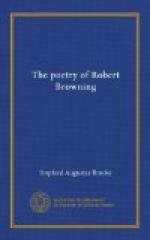Then there is How it strikes a Contemporary—the story of the gossip of a Spanish town about a poor poet, who, because he wanders everywhere about the streets observing all things, is mistaken for a spy of the king. The long pages he writes are said to be letters to the king; the misfortunes of this or that man are caused by his information. The world thinks him a wonder of cleverness; he is but an inferior poet. It imagines that he lives in Assyrian luxury; he lives and dies in a naked garret. This imaginative representation might be of any time in a provincial town of an ignorant country like Spain. It is a slight study of what superstitious imagination and gossip will work up round any man whose nature and manners, like those of a poet, isolate him from the common herd. Force is added to this study by its scenery. The Moorish windows, the shops, the gorgeous magistrates pacing down the promenade, are touched in with a flying pencil; and then, moving through the crowd, the lean, black-coated figure, with his cane and dog and his peaked hat, clear flint eyes and beaked nose, is seen, as if alive, in the vivid sunshine of Valladolid. But what Browning wished most to describe in this poem was one of the first marks of a poet, even of a poor one like this gentleman—the power of seeing and observing everything. Nothing was too small, nothing uninteresting in this man’s eyes. His very hat was scrutinising.
He stood and watched the cobbler
at his trade,
The man who slices lemons
into drink,
The coffee-roaster’s
brazier, and the boys
That volunteer to help him
turn its winch.
He glanced o’er books
on stalls with half an eye,
And fly-leaf ballads on the
vendor’s string,
And broad-edged bold-print
posters by the wall.
He took such cognisance of
man and things,
If any beat a horse you felt
he saw;
If any cursed a woman, he
took note;
Yet stared at nobody, you
stared at him,
And found, less to your pleasure
than surprise,
He seemed to know you and
expect as much.
That is the artist’s way. It was Browning’s way. He is describing himself. In that fashion he roamed through Venice or Florence, stopping every moment, attracted by the smallest thing, finding a poem in everything, lost in himself yet seeing all that surrounded him, isolated in thinking, different from and yet like the rest of the world.
Another poem—My Last Duchess—must be mentioned. It is plainly placed in the midst of the period of the Renaissance by the word Ferrara, which is added to its title. But it is rather a picture of two temperaments which may exist in any cultivated society, and at any modern time. There are numbers of such men as the Duke and such women as the Duchess in our midst. Both are, however, drawn with mastery. Browning has rarely done his work with more insight, with greater keenness of portraiture, with happier brevity and selection. As in The Flight of the Duchess, untoward fate has bound together two temperaments sure to clash with each other—and no gipsy comes to deliver the woman in this case. The man’s nature kills her. It happens every day. The Renaissance society may have built up more men of this type than ours, but they are not peculiar to it.




